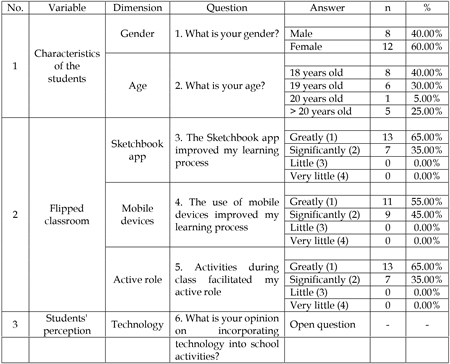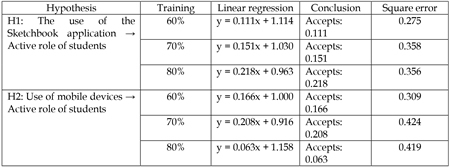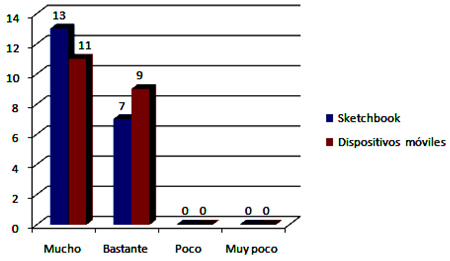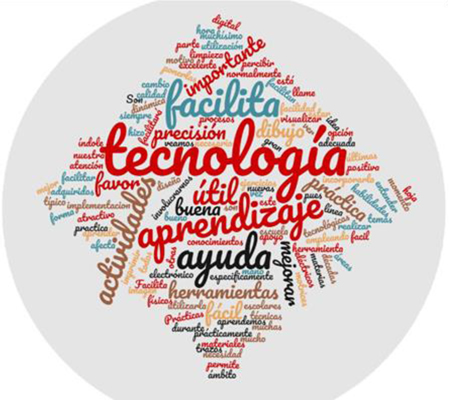
Figure 1. Proposed technological acceptance model.
doi.org/10.15178/va.2021.154.e1238
RESEARCH
ANALYSIS OF THE IMPACT OF FLIPPED CLASSROOM AND TECHNOLOGY IN THE EDUCATIONAL PROCESS ON THE DESIGN OF GRAPHIC COMMUNICATION
ANÁLISIS SOBRE EL IMPACTO DEL AULA INVERTIDA Y LA TECNOLOGÍA EN EL PROCESO EDUCATIVO SOBRE EL DISEÑO DE LA COMUNICACIÓN GRÁFICA
ANÁLISE SOBRE O IMPACTO DA SALA DE AULA INVERTIDA E DA TECNOLOGIA NO PROCESSO EDUCACIONAL NO DESIGN DE COMUNICAÇÃO GRÁFICA
Ricardo-Adán Salas-Rueda
Ana-Libia Eslava-Cervantes1
Estefanía Prieto-Larios1
1Institute of Applied Sciences and Technology, National Autonomous University of Mexico. Mexico.
1Institute of Applied Sciences and Technology, National Autonomous University of Mexico. Mexico.
1Institute of Applied Sciences and Technology, National Autonomous University of Mexico. Mexico.
ABSTRACT
The objective of this mixed research is to analyze the impact of the flipped classroom in the educational process on the Design of Graphic Communication. The sample is made up of 20 students who took the Formal Expression I course at a public university in Mexico City during the 2020 school year. This research proposes the consultation of the videos before the class and use of the Sketchbook application during the face-to-face session through mobile devices. The Sketchbook application allows analyzing the images of the human face, draw and check the dimensions of the objects through mobile devices. At home, the students consulted the videos about the Sketchbook application to learn the use of this technological tool. The results of machine learning (linear regression) indicate that the use of the Sketchbook application and mobile devices in the learning process positively influences the active role of the students. The flipped classroom allows the construction of new educational spaces where students actively participate during the educational process. Finally, the flipped classroom is a pedagogical model that is transforming the organization and implementation of the activities in the 21st century with the support of technology.
KEY WORDS: Flipped classroom, Technology, Education, Teaching, ICT, Educational technology,Learning
RESUMEN
El objetivo de esta investigación mixta es analizar el impacto del aula invertida en el proceso educativo sobre el Diseño de la Comunicación Gráfica. La muestra está compuesta por 20 alumnos que cursaron la asignatura Expresión Formal I en una universidad pública de la Ciudad de México durante el ciclo escolar 2020. Esta investigación propone la consulta de videos antes de la clase y el uso de la aplicación Sketchbook durante la sesión presencial por medio de los dispositivos móviles. La aplicación Sketchbook permite analizar las imágenes del rostro humano, dibujar y comprobar las dimensiones de los objetos por medio de los dispositivos móviles. En la casa, los estudiantes consultaron los videos sobre la aplicación Sketchbook con la finalidad de aprender el uso de esta herramienta tecnológica. Los resultados del aprendizaje automático (regresión lineal) indican que el uso de la aplicación Sketchbook y los dispositivos móviles en el proceso de aprendizaje influyen positivamente el rol activo de los estudiantes. El aula invertida permite la construcción de nuevos espacios educativos donde los alumnos participan activamente durante el proceso educativo. Por último, el aula invertida es un modelo pedagógico que está transformando la organización y realización de las actividades en el Siglo XXI con el apoyo de la tecnología.
PALABRAS CLAVE: Aula invertida, Tecnología, Educación, Enseñanza,TIC, Tecnología educativa, Aprendizaje
RESUMO
O objetivo desta pesquisa mista é analisar o impacto da sala de aula invertida no processo educativo sobre o design de comunicação Gráfica. A amostra é composta por 20 estudantes que cursaram a matéria Expresión Formal I em uma universidade pública da Cidade do México durante o ciclo letivo de 2020. Esta pesquisa propõe a consulta de vídeos antes da aula e o uso do aplicativo Sketchbook durante a sessão presencial por meio de dispositivos móveis. O aplicativo Sketchbook permite analisar as imagens do rosto humano, desenhar e verificar as dimensões dos objetos através de dispositivos móveis. Em casa, os alunos consultaram os vídeos sobre o aplicativo Sketchbook com a finalidade de aprender a usar esta ferramenta tecnológica. Os resultados do aprendizado automático (regressão linear) demonstram que o uso do aplicativo Sketchbook e os dispositivos móveis no processo de aprendizado influenciam positivamente no papel ativo dos alunos. A sala de aula invertida permite a construção de novos espaços educativos onde os estudantes participam ativamente durante o processo educativo. Por último, a sala de aula invertida é um modelo pedagógico que está transformando a organização e realização das atividades no século XXI com o apoio da tecnologia.
PALAVRAS CHAVE: Sala de aula Invertida, Tecnologia,Educação, Ensino, TIC, Tecnologia educativa, Aprendizado
Correspondence:
Ricardo-Adán Salas-Rueda. Institute of Applied Sciences and Technology, National Autonomous University of Mexico. Mexico. ricardo.salas@icat.unam.mx
Ana-Libia Eslava-Cervantes. Institute of Applied Sciences and Technology, National Autonomous University of Mexico. Mexico. libia.eslava@icat.unam.mx
Estefanía Prieto-Larios. Institute of Applied Sciences and Technology, National Autonomous University of Mexico. Mexico. estefaníaprietolarios@gmail.com
Received: 23/05/2020.
Accepted: 06/07/2020.
Published: 12/03/2021.
Como citar el artículo:
Salas-Rueda, R. A., Eslava-Cervantes, A. L. y Prieto-Larios, E. (2021). Analysis about the impact of flipped classroom and technology in the educational process on the Design of Graphic Communication. Vivat Academia. Revista de Comunicación, 154, 25-39. http://doi.org/10.15178/va.2021.154.e1238
http://www.vivatacademia.net/index.php/vivat/article/view/1238
Acknowledgments. This research product was supported by the “El Aula del Futuro” project. The participation of the academics is appreciated: Dr. Clara Alvarado Zamorano, Dr. Gustavo De la Cruz Martínez, M. in P. Jesús Ramírez Ortega, M. A. Ricardo Castañeda Martínez, and M. in I. Antonio M. Garcés Madrigal.
Translation by Paula González (Universidad Católica Andrés Bello, Venezuela).
1. INTRODUCTION
The flipped classroom is a blended learning modality that facilitates the participation of students inside and outside the classroom (Hew & Lo, 2018). The use of this pedagogical model is increasing in universities because teachers seek to innovate the educational process with the support of technological tools and educational web platforms (Busebaia & John, 2020; Hew & Lo, 2018; Rui et al., 2017). In fact, the flipped classroom replaces the activities carried out in the classroom with the development of individual and collaborative tasks at home (Bakla, 2018; Uskokovi?, 2018). In fact, this pedagogical model allows the creation of educational spaces that increase the satisfaction and motivation of students during the teaching-learning process (Busebaia & John, 2020; Tague & Czocher, 2016).
Before the face-to-face session, the students consult the multimedia resources from anywhere (Rui et al., 2017; Tague & Czocher, 2016). In the classroom, teachers organize creative individual and collaborative activities that facilitate the active role of students (Barbour & Schuessler, 2019; Tague & Czocher, 2016). Teachers have the possibility of updating courses, innovating school activities inside and outside the classroom, and organizing new educational virtual spaces through the flipped classroom (He, Holton, & Farkas, 2018; Salas-Rueda, 2020; Zainuddin, 2018). In fact, this pedagogical model favors active participation before, during, and after class (Barbour & Schuessler, 2019; Hermsen, Mokadam, & Verrier, 2019).
The objective of this mixed research is to analyze the impact of the flipped classroom in the educational process on the Design of Graphic Communication. Therefore, the research questions are:
1.1. Flipped classroom
In the 21st century, the flipped classroom is radically changing the functions of the participants in the educational process during the organization and implementation of school activities (Bakla, 2018; Busebaia & John, 2020). For example, teachers look for new pedagogical models that facilitate the assimilation of knowledge and the development of skills in students (Rotellar & Cain, 2016). The flipped classroom with the support of Information and Communication Technologies (ICTs) improved the teaching-learning conditions in Medicine courses (Hew & Lo, 2018; Rui et al., 2017), Computer Science (Salas-Rueda, 2020), Pediatrics (Busebaia & John, 2020), and Mathematics (Salas-Rueda, 2018; Tague & Czocher, 2016).
Teachers use pedagogical models and new technologies in the educational field to improve the learning process (Hew & Lo, 2018; Salas-Rueda, 2015). In the Medicine course, the flipped classroom facilitates the active participation of students before the face-to-face session by consulting videos and digital readings (Hew & Lo, 2018). At the beginning of the face-to-face session, the resolution of online exams improved academic performance (Hew & Lo, 2018). Medical students also have the main role in the educational process by doing collaborative activities in the classroom (Hew & Lo, 2018).
The flipped classroom promotes the use of technological tools, educational software, and web applications to facilitate the learning process and develop students' skills (Salas-Rueda, 2018). Outside the classroom, the students of the Computational Mathematics course consulted the videos to acquire knowledge about the use of the FreeDFD application (Salas-Rueda, 2018). In the classroom, the students solved the exercises collaboratively and verified the results through the FreeDFD application (Salas-Rueda, 2018). Finally, the students of the Computational Mathematics course solved the laboratory practices after the face-to-face session using the FreeDFD application (Salas-Rueda, 2018).
The flipped classroom has improved teaching-learning conditions at all educational levels (Bakla, 2018; Rui et al., 2017; Tague & Czocher, 2016). In the Differential Equations course, the students consulted the web animations at home to facilitate the assimilation of knowledge (Tague & Czocher, 2016). The web animations on the web equations contain various questionnaires that allow evaluating the academic performance of students (Tague & Czocher, 2016). The resolution of the exercises and the holding of discussion forums in the classroom facilitated the active participation of students and improved academic performance (Tague & Czocher, 2016).
In the Health field, teachers consider that the interpretation of the electrocardiogram is one of the most difficult topics to learn during clinical diagnoses (Rui et al., 2017). Therefore, the flipped classroom represents an excellent alternative to improve the teaching-learning process in the area of Medicine (Rui et al., 2017). Medicine students consulted multimedia resources, e-book chapters, and digital readings on the functioning of the heart at home (Rui et al., 2017). In the classroom, discussion forums and collaborative work allowed the active role of students (Rui et al., 2017). The results of the flipped classroom are the improvement of academic performance, increased satisfaction, and development of skills in students (Rui et al., 2017).
Today, teachers can redesign courses through the flipped classroom (Busebaia & John, 2020). In the Pediatrics course, students reviewed the digital presentations and consulted the videos at home (Busebaia & John, 2020). During the face-to-face session, the resolution of case studies, the holding of discussion forums, and the presentation of the topics facilitated the active role of the students (Busebaia & John, 2020). After the face-to-face session, the Pediatric students solved the exams online (Busebaia & John, 2020).
The flipped classroom allows organizing and carrying out new activities before, during, and after class through the use of web applications and collaborative work (Salas-Rueda, 2020). Before the face-to-face session, the Computer Science students consulted the videos on the use of the database to insert, update, delete, and consult the information (Salas-Rueda, 2020). During the face-to-face session, collaborative work and the use of the MySQL application facilitated the assimilation of knowledge about the use of databases and developed the technological skills of the students (Salas-Rueda, 2020). After the face-to-face session, the Computer Science students had active participation by carrying out the laboratory practices (Salas-Rueda, 2020). The use of the flipped classroom in the field of Computer Science increased the motivation and performance of the students by carrying out the activities before, during, and after the class (Salas-Rueda, 2020).
Uskokovi? (2018) proposes that flipped classroom activities include conducting discussion forums and online exams before the face-to-face session, conducting discussion forums during the face-to-face session, and collaboratively developing tasks after the face-to-face session to facilitate the assimilation of knowledge and develop skills in students.
The flipped classroom improves teaching-learning conditions with the support of technological tools (Busebaia & John, 2020; He, Holton, & Farkas, 2018; Tague & Czocher, 2016). In fact, educational institutions use this pedagogical model to organize creative activities before, during, and after the face-to-face session (Barbour & Schuessler, 2019; Busebaia & John, 2020; Uskokovi?, 2018).
2. OBJECTIVES
The general objective of this mixed research is to analyze the impact of the flipped classroom in the educational process on the Design of Graphic Communication. The sample is made up of 20 students who took the subject Formal Expression I at a public university in Mexico City during the 2020 school year.
The particular objectives of this research are (1) to analyze the impact on the use of the Sketchbook application under the flipped classroom modality, (2) analyze the impact on the use of mobile devices under the flipped classroom modality, and (3) analyze students' perceptions on the use of technology under the flipped classroom modality.
3. METHODOLOGY
Next, the methodology used in this mixed research is presented through the sections of Procedure, Data Collection, and Data Analysis.
3.1. Procedure
The professor of the subject Formal Expression I studied the 2020 Aula del Futuro Diplomat taught by the National Autonomous University of Mexico (UNAM by its acronym in Spanish) to improve teaching-learning conditions. This Diplomat uses the techno-pedagogical model proposed by Gamboa-Rodríguez (2015) to transform the educational process through pedagogy and technology.
The 2020 Aula del Futuro Diplomat allowed transforming the activities of the Formal Expression I subject before and during the face-to-face session under the flipped classroom modality.
This research proposes the consultation of videos before the class and the use of the Sketchbook application during the face-to-face session through mobile devices. At home, the students of the Degree in Graphic Communication Design consulted the videos on the Sketchbook application to learn the use of this technological tool.
During the face-to-face session, the students of the Formal Expression I subject used the Sketchbook application to facilitate the assimilation of knowledge about the outline of the human face. In the classroom, students analyzed the images of the human face, drew and checked its dimensions on mobile devices using the Sketchbook application. Figure 1 shows the technological acceptance model used in this research.
Source: self-made.

Figure 1. Proposed technological acceptance model.
The research hypotheses related to the use of the flipped classroom in the teaching-learning process are:
3.2. Data collection
The data collection was carried out at a public university in Mexico City during February 2020. The measurement instrument is a questionnaire that consists of 5 closed questions and 1 open question (See Table 1).
Table 1. Questionnaire on the use of the flipped classroom.

Source: self- made.
3.3. Data analysis
This research uses the Rapidminer application to evaluate the research hypotheses on the use of the flipped classroom in the educational process on the Design of Graphic Communication. The training section (60%, 70%, and 80% of the sample) allows the calculation of linear regressions on the Sketchbook application and the use of mobile devices. The evaluation section (40%, 30%, and 20% of the sample) allows identifying the accuracy of these linear regressions through the squared error.
On the other hand, the Wordclouds application allows analyzing students' perceptions about the use of technology in the flipped classroom through the word cloud.
4. RESULTS AND DISCUSSION
The results of the flipped classroom in the educational process on Graphic Communication Design are presented below. The activities during the class facilitated greatly (n = 13, 65.00%) and significantly (n = 7, 35.00%) the active role of the students (See Table 1). Likewise, the results of automatic learning (linear regression) indicate that the use of the Sketchbook application and mobile devices in the learning process positively influences the active role of students under the flipped classroom modality (See Table 2).
Table 2. Results of automatic learning.

Source: self-made.
4.1. The use of the Sketchbook application
The Sketchbook application improved the learning process greatly (n = 13, 65.00%) and significantly (n = 7, 35.00%) (See Table 1). Likewise, the results of automatic learning with 60% (0.111), 70% (0.151), and 80% (0.218) of training indicate that Hypothesis 1 is accepted (See Table 2). Therefore, the use of the Sketchbook application in the learning process positively influences the active role of students under the flipped classroom modality.
4.2. Use of mobile devices
The use of mobile devices improved greatly (n = 11, 55.00%) and significantly (n = 9, 45.00%) the learning process (See Table 1). Likewise, the results of automatic learning with 60% (0.166), 70% (0.208), and 80% (0.063) of training indicate that Hypothesis 2 is accepted (See Table 2). Therefore, the use of mobile devices in the learning process positively influences the active role of students under the flipped classroom modality.
Graph 1 shows the results of the use of the Sketchbook application and mobile devices in the flipped classroom.
Source: self-made.

Graph 1. Use of the Sketchbook application and mobile devices in the flipped classroom.
4.3. Students' perceptions
Technological advances are changing the way users interact with content. Students of the Degree in Graphic Communication Design think that the use of the Sketchbook application in the flipped classroom is very useful during the teaching-learning process.
“It is something very useful because technology is used more and more in life and incorporating it into learning makes things easier and helps to be more up-to-date” (Student 18, female,> 20 years old).
"It was very useful to me since you can see with more certainty details that we normally cannot perceive" (Student 19, female, 18 years old).
The flipped classroom allows the organization of creative activities during the teaching-learning process. In particular, the Sketchbook application facilitates the assimilation of knowledge through drawing and using objects.
"That its use helps us to have more ease and precision when drawing, so it is a very good option for design" (Student 4, male, 18 years old).
"It greatly facilitates various aspects such as precision, cleanliness, line quality, and the work itself" (Student 10, male 19 years old).
Teachers use the flipped classroom to build new educational spaces where students actively participate inside and outside the classroom. For example, students mention that the Sketchbook application allows for innovative and creative activities.
“It is very successful, it makes it easier to understand and it gives a change to the typical, which makes it more attractive” (Student 13, male,> 20 years old).
"The use of new technological tools allows us to get more involved in any field of drawing and to learn about things and techniques in a more practical way without having to use physical materials" (Student 15, male, 19 years old).
Incorporating technology into school activities facilitates learning and skill development. The Sketchbook application makes it easy to draw and handle images.
"It seems easier to me since they facilitate several strokes that by hand are more difficult to do and that you can use any image without having to print, among other tools" (Student 9, male, 20 years old).
“It is necessary and I consider that not everyone has the motor skills to do something on a sheet, but they can on a device” (Student 20, female, 19 years old).
Pedagogical models such as the flipped classroom and the use of technological tools improve teaching-learning conditions. In Formal Expression I, students consider that the use of the Sketchbook application increases students' motivation.
“They are a great support to perform more exercises and in a more practical way on topics that we see. It makes a more dynamic class” (Student 16, female, 18 years old).
"That it positively affects our learning, since it makes us more interested and makes us have, or rather, motivates us to learn and use technology in our favor" (Student 17, female, 19 years old).
The word cloud shows that technology, learning, useful, facilitates, important, activities, and help are the most repeated words (See Figure 2).
Source: self-made.

Figure 2. Word cloud on the use of technology in the flipped classroom.
4.4. Discussion
Technological advances together with pedagogical models are changing the way of interacting between users and content. In particular, the students of the Bachelor of Graphic Communication Design think that the use of the Sketchbook application on mobile devices is very useful during school activities in the flipped classroom modality. In fact, most of the students (n = 13, 65.00%) think that the activities during the class greatly facilitated their active role.
Most of the students (n = 13, 65.00%) consider that the Sketchbook application greatly improved the learning process. Likewise, the results of automatic learning on Hypothesis 1 are higher than 0.110, therefore, the use of the Sketchbook application in the learning process positively influences the active role of students under the flipped classroom modality.
On the other hand, most of the students (n = 11, 55.00%) consider that the use of mobile devices greatly improved the learning process. Likewise, the results of automatic learning on Hypothesis 2 are higher than 0.062, therefore, the use of mobile devices in the learning process positively influences the active role of students under the flipped classroom modality.
The flipped classroom transformed the role of the teacher and the students in the Formal Expression Isubject through Information and Communication Technologies. In particular, the Sketchbook application facilitates the assimilation of knowledge through drawing and using objects. Likewise, technology allows creating educational spaces that are attractive and interesting for students.
Furthermore, the flipped classroom facilitates the organization of creative activities that promote the development of skills in students. For example, students of the Bachelor of Graphic Communication Design think that the Sketchbook application facilitates the drawing of lines and the handling of images. The use of technology in the subject Formal Expression I also increases the motivation of students during the learning process.
5. CONCLUSION
The flipped classroom facilitates the construction of new spaces where the student learns the topics of the courses and develops their skills. In particular, this research transforms the teaching-learning process in the Formal Expression I subject through technological tools and the flipped classroom. The results of automatic learning (linear regression) indicate that the use of the Sketchbook application and mobile devices in the learning process positively influences the active role of students.
The role of the participants in the educational process is transformed under the flipped classroom modality. For example, the teacher finds and selects the videos on the Sketchbook application and prepares the activities for the face-to-face session. On the other hand, the student actively participates during the teaching-learning process by consulting the videos before class and using technology in the classroom.
Students of the Bachelor of Graphic Communication Design think that the use of the Sketchbook application on mobile devices facilitates the assimilation of knowledge about the outline of the human face and develops skills related to drawing. The limitations of this research are the sample size and the use of the Sketchbook application on mobile devices. Therefore, future research can analyze the impact of the flipped classroom in groups with a greater number of students and evaluate the incorporation of other technological tools such as social networks and augmented reality before, during, and after the face-to-face session.
This mixed research recommends the use of the flipped classroom in the educational field because this pedagogical model, together with technology, facilitates the active role of students during the learning process. Finally, teachers can innovate school activities, improve teaching-learning conditions, encourage active participation of students, facilitate the assimilation of knowledge, and develop the skills of the participants in the educational process through the flipped classroom.
6. REFERENCES
AUTHORS:
Ricardo-Adán Salas-Rueda
Doctor in Design of New Technologies. Full-time researcher at the Institute of Applied Sciences and Technology, National Autonomous University of Mexico. National Researcher SNI level 1 (2019-2021).
ricardo.salas@icat.unam.mx
Orcid ID: http://orcid.org/0000-0002-4188-4610
Google Scholar: https://scholar.google.com/citations?hl=es&user=avsvdDUAAAAJ
Ana-Libia Eslava-Cervantes
Institute of Applied Sciences and Technology, National Autonomous University of Mexico. Mexico.
libia.eslava@icat.unam.mx
Orcid ID: https://orcid.org/0000-0002-7420-3412
Estefanía Prieto-Larios
The National Autonomous University of Mexico. Mexico.
estefaníaprietolarios@gmail.com
Orcid ID: https://orcid.org/0000-0002-8140-2778